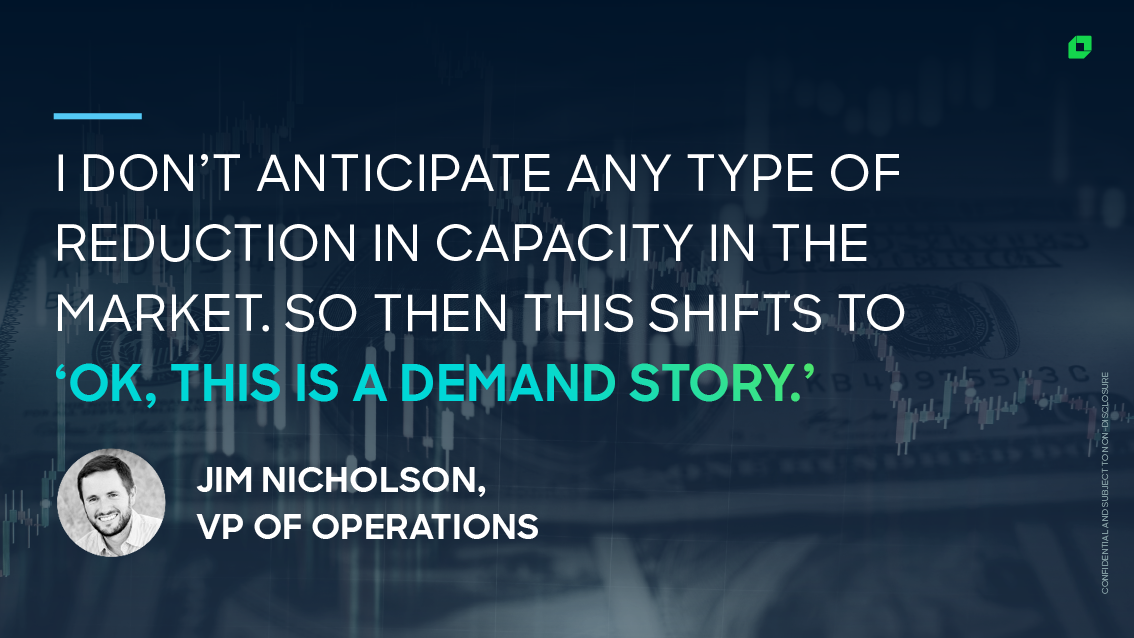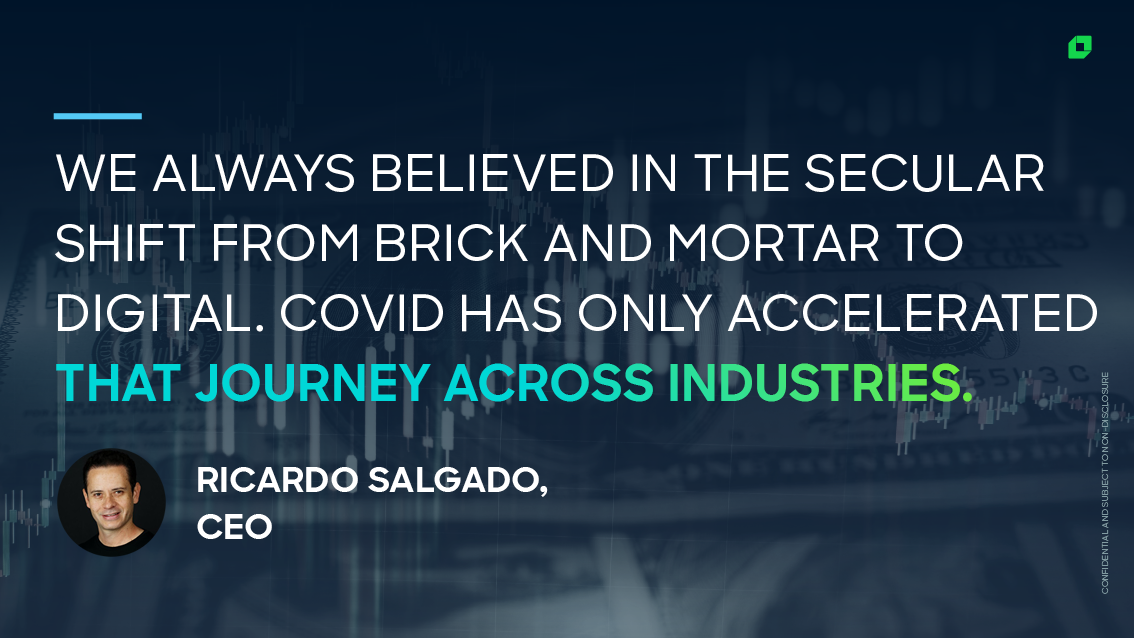Share this
Loadsmart First Look Monthly Market Recap: July
by aaronroseman
Welcome to July’s Episode of Loadsmart First Look. This will be a monthly series that dives into the domestic freight market, the economy as a backdrop to the trucking industry, and the latest developments and technologies that are changing the supply chain.
Joining our moderator, Ethan Feldman, for our first episode is Jim Nicholson, the VP of Carrier Sales and Ricardo Salgado, CEO to discuss what they’re seeing in the freight market, how to reconcile record freight volume with record levels of unemployment, and the adoption of tech during Covid.
What’s going on in the market?
Ethan: Jim – I wanted to ask you the first question more of a macro view, what are you seeing in the freight market?

Jim: Post memorial day you really saw this gradual increase and then as you got further into June and more states were opening up more activities were coming back online that acceleration increased to where you see today where volumes are at all times high, plus 20% over prior years and rejects and capacity continues to be very much constrained. Post July 4th typically you see a drop off, but that absolutely is not the case this year and to me all seasonality trends in the market that typically follow, 2020 is just out the window.
What markets do you have your eye on?
Ethan: Could you speak to more specific markets and what you’re seeing in some of the hotter areas of the country?
Jim: One that we haven’t been seeing or talking too much about that I think is really interesting is the Mexico-US cross border. Laredo – Mexico is a top 3 trade partner over $500 billion annually with the US – and Laredo is by and large the largest entry to the US from Mexico of 40%. What we’re seeing in Laredo is volumes that are nearly double to the prior two years and you’re also seeing some of this in El Paso and McAllen as well. But what does this mean? There is a severe backlog of what Mexico produces for the US.
Why are we seeing record levels of volume, but historic levels of unemployment?
Ethan: So I wanted to ask Ricardo, a question I’ve been getting from my customers. How do you reconcile the freight industry reporting record volumes, record outbound tender rejection, with the look of the everyday American, spending is down?
Ricardo: That’s a fair statement and can be a bit confusing because typically economic activity is represented 2/3 by consumer spending. So given the uncertainty and unemployment that you’re seeing why on earth are rates up to the levels they are right now or why are volumes up 20% year over year?
And it’s around end customers of trucking, and a big chunk of full truckload are essential services. Think about consumer staples, CPG essentials, such as food, beverage, water, pharma. So maybe instead of eating out at a restaurant, for example, where you use Ketchup to eat your fries, now you do that at home. You still consume that, so maybe you saw some shift from trucking being delivered into that restaurant into a grocery that ultimately ends up in your home. So net net, things still need to move. We have been able to help supplement these movements through technology. So for by digitizing, for example the pipelines into shippers, by integration into their transportation management system. That has allowed them to be much more efficient and procure capacity in a digital format
Ethan: That was a great take on the demand side, Jim do you want to talk about how stimulus running out may be effecting what we’re going to see capacity look like?

Jim: Total count of tractors did decline for the first time some time since in April. But that wasn’t necessarily unexpected. It was less than 1% and it actually rebounded back in June. And more recently with the benefits of PPE which really helped truckload operators. We saw Class 8 truck sales increase 20% year over year. Another dynamic that’s kind of interesting is the used truck three years was actually positive for the first in quite some time. I don’t anticipate any type of reduction in capacity in the market. So then this shifts to ‘ok, this is a demand story.’
How is freight tech influenced by all of this?
Ethan: So, I know Ricardo has a spin class that he needs to get to. So we’ll wrap it up quickly. More than ever the world’s largest and most sophisticated shippers are leveraging technology to drive efficiencies in their supply chain. And there’s been a lot of exciting developments. But, Ricardo I was hoping you could tell us a little bit more about what you’re seeing.

Ricardo: We always believed – even pre-covid – in the secular shift from brick and mortar, analog to digital slash online. And Covid has only accelerated that journey across most industries. And for us it’s exactly the same thing. We saw more integrations in Q2 in 2020 than all of 2019. So I would say that this is something that is getting the attention of transportation leaders. Thematically what we see is that transportation leaders were very focused on the primary goal which was to get goods moved from A to B and probably a little bit of technology, and now that little bit of technology has expanded significantly.
Keep up with all the latest weekly and monthly market insights on our Youtube page. Questions about anything you saw? Email sales@loadsmart.com and let’s talk about how we can help you take advantage of real-time market conditions.
Share this
- Loadsmart Blog (159)
- Blog (121)
- Shipper (106)
- Market Trends (100)
- Enterprise Shipper (69)
- Carrier (66)
- News (62)
- Data Insights (51)
- Thought Leadership (45)
- Warehouse (41)
- SMB Shipper (38)
- Our Partners (34)
- ShipperGuide TMS (31)
- Opendock (30)
- Product Updates (29)
- Mode Optimization (25)
- Loadsmart (23)
- Mid-Market Shipper (18)
- Case Study (17)
- Brokerage Services (15)
- Managed Transportation (11)
- Video (9)
- Award (7)
- FreightIntel AI (5)
- Instant Execution (4)
- Asset (3)
- Food and Beverage (3)
- Freight Management (3)
- Logistics Solutions (3)
- YMS (3)
- eBook (3)
- 4PL (2)
- International (2)
- NavTrac (2)
- Podcast (2)
- UK (2)
- Yard Management System (2)
- Cold Storage (1)
- Faces of Loadsmart (1)
- Paper Packaging (1)
- Retail (1)
- Security (1)
- Transportation Management System (1)
- December 2025 (1)
- November 2025 (1)
- October 2025 (2)
- September 2025 (1)
- August 2025 (1)
- July 2025 (1)
- June 2025 (1)
- May 2025 (7)
- April 2025 (6)
- March 2025 (3)
- February 2025 (10)
- January 2025 (4)
- December 2024 (4)
- November 2024 (5)
- October 2024 (11)
- September 2024 (11)
- August 2024 (5)
- July 2024 (5)
- June 2024 (9)
- May 2024 (7)
- April 2024 (6)
- March 2024 (2)
- February 2024 (2)
- January 2024 (5)
- December 2023 (6)
- November 2023 (2)
- October 2023 (12)
- September 2023 (5)
- August 2023 (3)
- July 2023 (4)
- June 2023 (10)
- May 2023 (5)
- April 2023 (5)
- March 2023 (7)
- February 2023 (5)
- January 2023 (7)
- December 2022 (4)
- November 2022 (13)
- October 2022 (4)
- September 2022 (7)
- August 2022 (11)
- July 2022 (6)
- June 2022 (5)
- May 2022 (2)
- April 2022 (4)
- March 2022 (6)
- February 2022 (7)
- January 2022 (9)
- December 2021 (3)
- November 2021 (5)
- October 2021 (7)
- September 2021 (2)
- August 2021 (2)
- July 2021 (4)
- June 2021 (6)
- May 2021 (6)
- April 2021 (5)
- March 2021 (8)
- February 2021 (3)
- January 2021 (3)
- December 2020 (7)
- November 2020 (9)
- October 2020 (7)
- September 2020 (6)
- August 2020 (10)
- July 2020 (8)
- June 2020 (3)
- May 2020 (1)
- April 2020 (2)
- March 2020 (2)
- February 2020 (1)
- January 2020 (1)
- November 2019 (2)
- October 2019 (1)
- September 2019 (2)
- August 2019 (3)
- July 2019 (2)
- June 2019 (2)
- May 2019 (3)
- March 2019 (1)
- February 2019 (3)
- December 2018 (1)
- November 2018 (2)
- October 2018 (1)
- September 2018 (2)
- August 2018 (1)
- July 2018 (1)
- June 2018 (3)
- May 2018 (4)
- April 2018 (1)
- February 2018 (1)
- January 2018 (4)
- November 2017 (1)
- October 2017 (2)
- June 2017 (1)
- May 2017 (2)
- April 2017 (1)
- February 2017 (1)
- January 2017 (2)
- October 2016 (1)
- August 2016 (1)
- July 2016 (2)
- June 2016 (1)
- March 2016 (1)
- January 2016 (1)
- December 2015 (3)
- November 2015 (2)
- October 2015 (6)
- July 2015 (1)
- June 2015 (1)
- April 2015 (2)
- March 2015 (13)
- February 2015 (17)
- January 2015 (15)
- December 2014 (35)
- November 2014 (26)
- October 2014 (60)
- September 2014 (2)